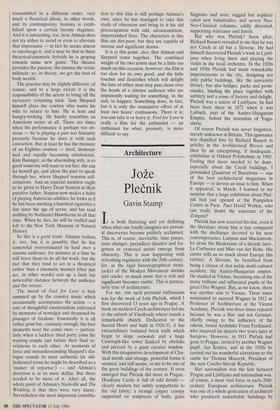Architecture
Joe Pleenik
Gavin Stamp
It is both flattering and yet deflating when what one fondly imagines are person- al discoveries become publicly acclaimed. This is, of course, inevitable; time passes, taste changes, prejudices dissolve and for- gotten or censored artists emerge from obscurity. This is now happening with refreshing regularity with the 20th century, for, as the rigid historiographical strait- jacket of the Modern Movement shrinks and cracks, so much more that is rich and significant becomes visible. This is particu- larly true of architecture.
For me, one such personal enthusiasm was for the work of Joie Pleenik, which I first discovered 13 years ago in Prague. A book on modern Czech architecture led me to the suburb of Vinohrady where stands a remarkable church. Dedicated to the Sacred Heart and built in 1928-33, it has extraordinary textured brick walls which begin to slope outwards and a huge Cenotaph-like tower flanked by obelisks and pierced by a giant circular window. With this imaginative development of Clas- sical motifs and strange, powerful forms it seemed, and still seems, to me to be one of the great buildings of the century. It soon emerged that Pleenik did more in Prague. Hrad6any Castle is full of odd details clearly modern but subtly sympathetic to the old fabric: a strange copper canopy supported on sculptures of bulls; giant flagpoles and urns; rugged but sophisti- cated new balustrades; and severe Neo- Neo-Classical columns, oddly distorted, supporting staircases and lintels.
But who was Ple6nik? Soon after, Richard Bassett revealed to me that he was not Czech at all but a Slovene. He had himself discovered Planik's work in Ljubl- jana when living there and playing the violin in the local orchestra. In the 1920s and 1930s Pleenik had made remarkable improvements to the city, designing not only public buildings, like the university library, but also bridges, parks and prom- enades, binding the place together with subtlety and a sense of history and delight. Pleenik was a native of Ljubljana; he had been born there in 1872 when it was Laibach, part of the Austro-Hungarian Empire, before the invention of Yugo- slavia.
Of course Pleenik was never forgotten, merelyunknown in Britain. This ignorance was dispelled first by Richard Bassett in articles in the Architectural Review and then by an enterprising, if inadequate, exhibition at Oxford Polytechnic in 1983. Feeling that more needed to be done, especially about the Czech buildings, I persuaded Quaderns of Barcelona — one of the best architectural magazines in Europe — to devote an issue to him. When it appeared, in March, I learned to my surprise that a large exhibition about Plee- nik had just opened at the Pompidou Centre in Paris. Pace David Watkin, who can really doubt the existence of the Zeitgeist?
Ple6nik has now received his due, even if the literature about him is tiny compared with the shelfspace devoted to his near contemporaries, Lutyens and Mackintosh, let alone the Modernists of a decade later, Le Corbusier and Mies van der Rohe. His career tells us so much about Europe this century. A Slovene, he benefited from being a citizen of that noble multi-cultural accident, the Austro-Hungarian empire. He studied in Vienna, becoming one of the many brilliant and influential pupils of the great Otto Wagner. But, as we know, there was another side to Vienna. Three times nominated to succeed Wagner in 1912 as Professor of Architecture at the Vienna Academy, Pleenik was three times rejected beCause he was a Slav and not German, chiefly owing to the influence of the odious, brutal Archduke Franz Ferdinand, who received his deserts two years later at Sarajevo. However, in 1911 Ple6nik had gone to Prague, invited by another Wagner pupil, Jan Kotera, and in the 1920s he carried out his wonderful alterations to the castle for Thomas Masaryk, President of the new Czecho-Slovak Republic.
Slav nationalism was the link between Prague and Ljubljana and nationalism was, of course, a most vital force in early-20th- century European architecture. Pleenik was one of a whole generation of architects who produced remarkable buildings by
reinterpreting local traditions with great invention. They worked all over Europe, from Gaudi in Barcelona to Saarinen in Helsinki. Many of these men continued into the 1920s and 1930s, tackling the new building types and new technologies thrown up by the new century but never discarding the lessons and power of tradi- tion. Unfortunately, so much of this `alternative' history of the 20th century has been ignored owing to the partisan (and Initially victorious) press of the Modern Movement. Now a more complex and much richer picture is emerging, and in it Ple'e'nik seems to me to be a towering figure.
In his delight in the texture and colour of masonry and in using massive stones, Planik seems 'Arts and Crafts', like many of his generation, but he never aban- doned the Classical language which, as a European, he seems to have regarded as his natural inheritance. What is interest- ing is what he does with that language; columns are used with a Byzantine distor- tion of proportion and the rules but never with that self-conscious irony which char- acterises the use of the orders by modern Post-Modernists. Planik, indeed, achieves so many of the qualities our Post- Modernists strive for: he reinvigorates tradition, he uses materials superbly, he can blend new and old and define and enhance urban spaces. His work is worth studying, certainly by English architects. In his use of the Classical language he was More imaginative and resourceful than even Lutyens; in his ability to add new work to old buildings he fulfils the ideals of William Morris more creatively than any English architect I can think of.



















































 Previous page
Previous page